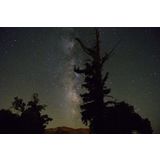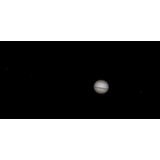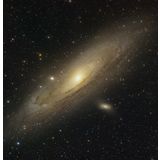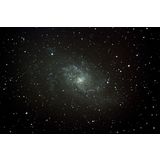
November presents some clear, cool nights for many locations (between winter storms). So bundle up and get outside for stargazing fun!
Milky Way-In early November, stretching from overhead to the southwestern horizon, you can still catch bright portions of the Milky Way. As the month goes on and Earth marches in its orbit around the Sun, the Milky Way will appear lower and lower to the western horizon. The Milky Way is a wonderful target to explore with 50mm or larger binoculars or a wide-field telescope; there are dozens of star clusters to pick out, even in moderately light polluted areas.
Big and Bright Jupiter-In Early November go outside about 9pm on a clear night. Face east and look about half way up towards the zenith, which is directly overhead. Here you'll easily see the bright and big planet Jupiter. Use a telescope to enjoy views of its four brightest moons (Io, Europa, Ganymede, and Callisto) and its striking equatorial cloud belts. A 3" or larger telescope will give rewarding views.
Fire in the Sky-On Saturday night, November 17 the Moon is only a few days old so the conditions are good for the late night appearance of the Leonids Meteor Shower. This shower is predicted to peak on the night of November 17 (and the morning of the 18th) and will have dozens of meteors per hour visible from a dark sky location. The Leonid shower is known for its bright meteors, the brightest of which leave a trail high in the sky that can take several seconds or longer to dissipate.
Best Galaxy Ever!-M31, The Andromeda Galaxy. Around 9pm in early November, M31 lies just north of the stars that form the constellation of Andromedea/NE of Pegasas. Use a star chart, planisphere, or your Orion StarSeek app to help find it with binoculars. You can take a better look with a telescope using a wide angle eyepiece. From a dark sky site this galaxy is an easy naked-eye object as well; Andromeda is the closest large galaxy to our own Milky Way, about 2 million light years away.
A Bright Spot in the Milky Way-High in the northern sky at 10pm is a brighter knot in the Milky Way, between the constellations of Perseus and Cassiopeia. With binoculars you can tell that it is really two open star clusters side by side, the famous Double Cluster in Perseus. Also called NGC 884 & NGC 889, these clusters are relatively close to Earth, about 7-8,000 light years away. They're also very young clusters. Astronomers believe these are only about 3-5 million years old, just "babies" on the cosmic timescale!
A Dark Sky Test-On the opposite side of Andromeda is another nearby galaxy, M33. Use a star chart to look for it in 50mm or larger binoculars. If you have a dark sky to observe from, you can even detect this galaxy with the unaided eye. In fact, M33 is used as a test by many experienced observers to judge the darkness and transparency of a potential observing site.
Catch a Dying Star-High in the western sky, early in the evening, the constellation of Cygnus is still prominent and topped off by the star Deneb at the top of the "Northern Cross". With a star chart, track down the Veil Nebula on the eastern side of Cygnus near the star 52 Cygni. Use an Oxygen III filter and low power while you scan for this object. The Veil is a remnant of a supernova explosion, where a star has died. We recommend a 4" or larger telescope to catch it (but it has been seen in smaller scopes from good dark sky locations).
November's Challenge Object-The Silver Dollar Galaxy, NGC 253. At 9pm, low in the south is the "starburst" galaxy NGC 253. From a dark sky, this grand galaxy is easy to see in binoculars and with a telescope, but can you see it with your naked eye? If you can see this challenging object without a telescope, you definitely have excellent skies (dark and transparent) and you are probably looking at the most distant object that a person can see without a telescope, about 11.5 million light years distant from Earth.
All objects described above can easily be seen with the suggested equipment from a dark sky site, a viewing location some distance away from city lights where light pollution and when bright moonlight does not overpower the stars. All objects have been verified by actual observations by Orion Telescopes & Binoculars Staff at Fremont Peak State Park, and/or Deep Sky Ranch, 60 miles and 90 miles respectively from San Jose International Airport, San Jose, CA.





















